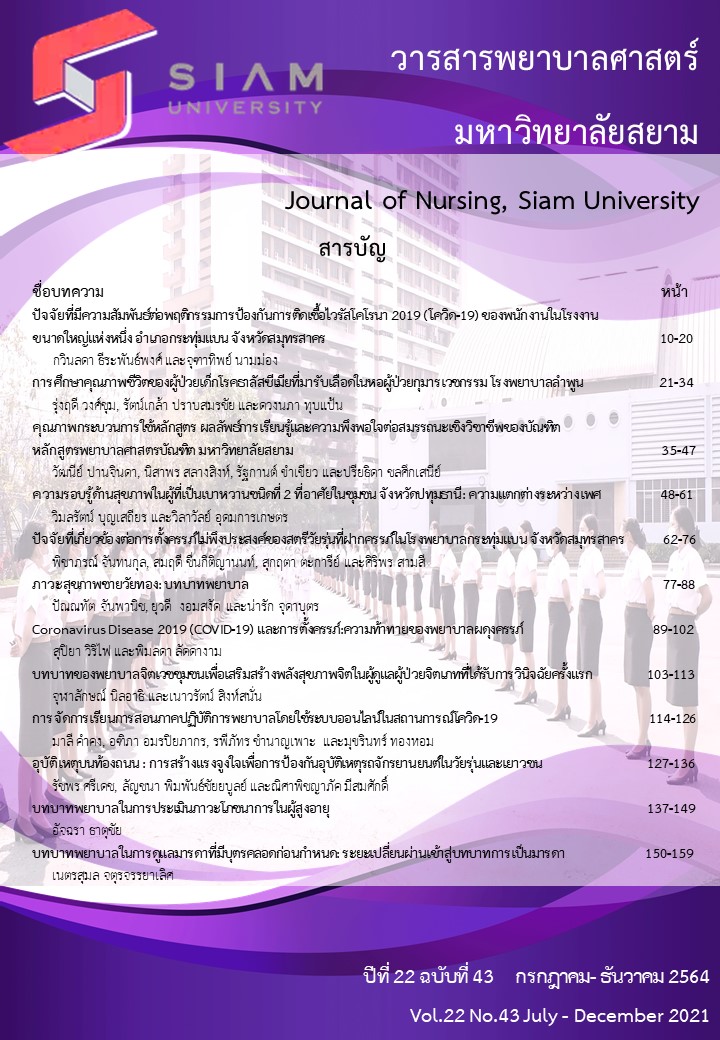Health Literacy in People with Type 2 Diabetes Living in Communities, Pathum Thani Province: Gender Differences
Keywords:
health literacy, sex, type 2 diabetesAbstract
This cross-sectional comparative descriptive study aimed to investigate health literacy level and compared health literacy between females and males with type 2 diabetes living in communities, Pathum Thani province. The 303 participants were randomly selected by multistage sampling method. The instrument comprised demographic data and health literacy for diabetes questionnaire. Demographic data and level of health literacy were analyzed using descriptive statistics and compared health literacy between females and males with diabetes by Mann Whitney U test. The results demonstrated that 54.4% females with diabetes had inadequate health literacy and 55.3% males with diabetes showed adequate health literacy. Males with diabetes had higher mean scores of health literacy sum scale (Z= -1.989, p=.047) and interactive health literacy subscale (Z= -2.005, p=.045) than females.
These research findings may help professional nurses realize the differences of health literacy between females and males with diabetes and enable them to modify health teaching method that is tailored to gender of patients with type 2 diabetes.
References
กองโรคไม่ติดต่อ กระทรวงสาธารณสุข. (2563). ข้อมูลโรคไม่ติดต่อ จำนวนอัตราป่วย ตาย ปี 2559-2562. Retrieved from http://www.thaincd.com/2016/mission/documents-detail.php?id=13893&tid=32&gid=1-020
ดุลยา จิตตะยโศธร. (2551). บทบาททางเพศ: ในทัศนะของนักจิตวิทยา. วารสารวิชาการ มหาวิทยาลัยหอการค้าไทย, 28(1), 195–208.
นวพร วุฒิธรรม, พิมพ์นิภา ศรีนพคุณ, และฐิติวัชร์ วารีรัตน์ภากร. (2564). ปัจจัยคัดสรรที่มีความสัมพันธ์กับความรอบรู้ทางสุขภาพในการควบคุม ระดับน้ำตาลในเลือดของผู้ป่วยโรคเบาหวานขนิดที่ 2. วารสารการพยาบาลทหารบก, 22(2), 252–259.
นันทวรรณ อุดม, สุภาพิชย์ ขวานทอง, ณฐมน ธนภรสุวรรณ, ประเสริฐ ประสมรักษ์, และจนัญญา โหง่นคา. (2564). เปรียบเทียบความรอบรู้ด้านสุขภาพและพฤติกรรมการดูแลสุขภาพของผู้ป่วยเบาหวานที่ไม่มีและมีภาวะแทรกซ้อน ในตำบลนาผือ อาเภอเมืองจังหวัดอานาจเจริญ. วารสารพยาบาลสาธารณสุข, 35(2), 77–93.
บุญสืบ โสโสม. (2560). การคำนึงถึงเพศสภาพ: ประเด็นสำคัญสำหรับการปฏิบัติในคลินิกและการศึกษาพยาบาล. วารสารคณะพยาบาลศาสตร์ มหาวิทยาลัยบูรพา, 25(2), 1–8.
พงษ์ศิริ งามอัมพรนารา, และสุจิตรา สุคนธทรัพย์. (2563). ความรอบรู้ด้านสุขภาพของผู้ป่วยโรคเบาหวานชนิดที่ 2 ในกรุงเทพมหานครและปริมณฑล. วารสารสุขศึกษา พลศึกษา และสันทนาการ, 46(2), 68–79.
ภานุวัฒน์ คำวังสง่า, และอรรถเกียรติ กาญจนพิบูลวงศ์. (2563). สถานการณ์โรคไม่ติดต่อตาม 9 เป้าหมายระดับโลกของประเทศไทย. In อรรถเกียรติ กาญจนพิบูลวงศ์, ภาณุวัฒน์ คำวังสง่า, & สุธิดา แก้วทา (Eds.), รายงานสถานการณ์โรค NCDs เบาหวาน ความดันโลหิตสูง และปัจจัยเสี่ยงที่เกี่ยวข้อง พ.ศ. 2562 (pp. 1–24). กรุงเทพมหานคร: สำนักพิมพ์อักษรกราฟฟิคแอนด์ดีไซน์.
ยวิษฐา สุขวาสนะ, อรพินท์ สีขาว, และทวีศักดิ์ กสิผล. (2564). ความสัมพันธ์ระหว่างปัจจัยส่วนบุคคล ความรอบรู้ด้านสุขภาพ พฤติกรรมการดูแลตนเองกับการควบคุมระดับน้ำตาลในเลือดของผู้ป่วยเบาหวานชนิดที่ 2. ราชาวดีสาร วิทยาลัยพยาบาลบรมราชชนนี สุรินทร์, 11(1), 52–65.
วิไล วิชากร. (2561). แบบรายงานการตรวจราชการระดับจังหวัด ปีงบประมาณ พ.ศ. 2561 คณะที่ 1 การส่งเสริมสุขภาพป้องกันโรคและการคุ้มครองผู้บริโภคด้านสุขภาพ หัวข้อ อัตราผู้ป่วยเบาหวานรายใหม่จากกลุ่มเสี่ยงเบาหวาน และ อัตราผู้ป่วยความดันโลหิตสูงรายใหม่จากกลุ่มสงสัยป่วยความดันโลหิตสูง จังหวัดปทุมธานีเขตสุขภาพที่ 4 ตรวจราชการวันที่ 9 – 13 กรกฎาคม 2561. Retrieved from http://bie.moph.go.th/e-insreport/file_report/2018-08-06-08-21-46-11.pdf
สมพร รุ่งเรืองกลกิจ, อิงคฏา โคตนารา, เนตรชนก แก้วจันทา, และชมพูนุท กาบคำบา. (2560). ทัศนคติของนักศึกษาในมหาวิทยาลัยแห่งหนึ่งต่อเพศภาวะในสังคมไทย. วารสารสังคมศาสตร์และมนุษยศาสตร์, 43(2), 84–114.
สิทธานนท์ แจ่มหอม, ทัศนีย์ ศิลาวรรณ, สุนีย์ ละกำปั่น, และจุฑาธิป ศีลบุตร. (2564). ความรอบรู้ด้านสุขภาพของผู้ป่วยโรคเบาหวานที่ควบคุมระดับน้้าตาลในเลือดไม่ได้ ในหน่วยบริการปฐมภูมิ อ้าเภอเมืองสิงห์บุรี จังหวัดสิงห์บุรี. วารสารสุขศึกษา, 44(1), 75–86.
Al Sayah, F., Majumdar, S. R., Williams, B., Robertson, S., & Johnson, J. A. (2013). Health literacy and health outcomes in diabetes: A systematic review. Journal of General Internal Medicine, 28(3), 444–452.
Bodur, A. S., Filiz, E., & Kalkan, I. (2017). Factors affecting health literacy in adults: A community based study in Konya, Turkey. International Journal of Caring Sciences, 10(1), 100–109.
Boonsatean, W., Carlsson, A., Dychawy Rosner, I, & Ostman, M. (2018). Sex-related illness perception and self-management of a Thai type 2 diabetes population: A cross-sectional descriptive design. BMC Endocrine Disorder, 18(1). DOI 10.1186/s12902-017-0229-8
Çaylan, A., Yayla, K., Öztora, S., & Dağdeviren, H. N. (2017). Assessing health literacy, the factors affecting it and their relation to some health behaviors among adults. Biomedical Research, 28(15), 6803-6807.
Charan, J., & Biswas, T. (2013). How to Calculate Sample Size for Different Study Designs in Medical Research? Indian Journal of Psychological Medicine, 35(2), 121–126.
Fransen, M. P., Von Wagner, C., & Essink-Bot, M. L. (2012). Diabetes self-management in patients with low health literacy: Ordering findings from literature in a health literacy framework. Patient Education and Counseling, 88(1), 44-53.
Goldman, B. (2017). Two minds: the cognitive differences between men and women. Retrieved from https://stanmed.stanford.edu/2017spring/how-mens-and-womens-brains-are-different.html
Hutteman, R., Hennecke, M., Orth, U., Reitz, A. K., & Specht, J. (2014). Developmental Tasks as a Framework to Study Personality Development in Adulthood and Old Age. European Journal of Personality, 28, 267–278.
Ishikawa, H., Takeuchi, T., & Yano, E. (2008). Measuring functional, communicative, and critical health literacy among diabetic patients. Diabetes Care, 31(5), 874–879.
Kim, S. H., & Lee, A. (2016). Health-Literacy-Sensitive Diabetes Self-Management Interventions: A Systematic Review and Meta-Analysis. Worldviews on Evidence-Based Nursing, 13(4), 324-333.
Nutbeam, D. (2000). Health literacy as a public health goal: A challenge for contemporary health education and communication strategies into the 21st century. Health Promotion International, 15(3), 259–267.
Souza, J. G., Apolinario, D., Magaldi, R. M., Busse, A. L., Campora, F., & Jacob-Filho, W. (2014). Functional health literacy and glycaemic control in older adults with type 2 diabetes: A cross-sectional study. BMJ Open, 4(e004180).
Tang, Y. H., Pang, S. M. C., Chan, M. F., Yeung, G. S. P., & Yeung, V. T. F. (2008). Health literacy, complication awareness, and diabetic control in patients with type 2 diabetes mellitus. Journal of Advanced Nursing, 62(1), 74-83.
Tiller, D., Herzog, B., Kluttig, A., & Haerting, J. (2015). Health literacy in an urban elderly East-German population - Results from the population-based CARLA study. BMC Public Health, 15(1), 883.
World Health Organization. (1998). Health promotion glossary. Geneva: WHO.
World Health Organization. (2014). Process of translation and adaptation of instruments. Retrieved from http://www.who.int/Substance_Abuse/Research_Tools/Translation/En/
Wu, Y., Wang, L., Cai, Z., Bao, L., Ai, P., & Ai, Z. (2017). Prevalence and risk factors of low health literacy: A community-based study in Shanghai, China. International Journal of Environmental Research and Public Health, 14(6), E628
Downloads
Published
How to Cite
Issue
Section
License
Content and information published in the Journal of Nursing, Siam University is the comment and responsibility of the authors.
Articles, information, images, etc. published in the Journal of Nursing. Siam University is the copyright of the Journal of Nursing, Siam University. If any person or entity wants to take all or part of it for publication for any purposes, please reference the Journal of Nursing, Siam University.



